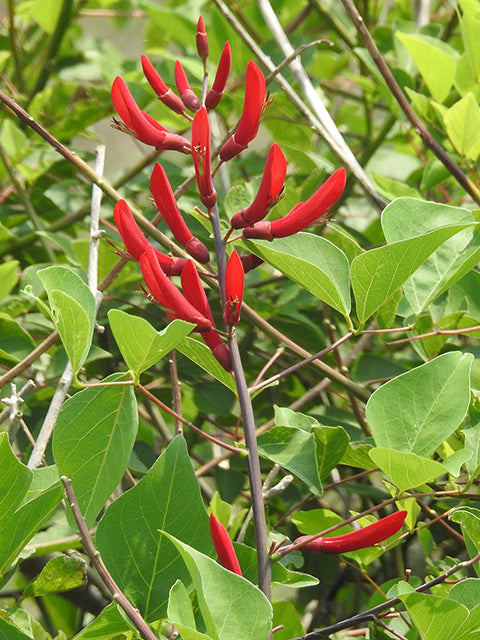Coralbean (Erythrina × bidwillii)
Coralbean (Erythrina × bidwillii)
Low stock: 6 left
Couldn't load pickup availability
Erythrina × bidwillii, commonly called coral tree or Bidwill's hybrid coral bean, is the result of a purposeful, interspecific cross between two Erythrina species: E. herbacea, native to the southern United States, and E. crista-galli, native to central South America. This plant is a deciduous, multi-stemmed shrub or small tree that can reach up to 12' tall and 10' wide. The compound leaves are made up to three, deltoid (triangle-shaped) leaflets. Clusters of bright red, 2" long blooms are held on the ends of terminal flowering stalks that can reach up to 3' long. Flowering begins in summer and continues until frost. In frost-free areas, this plant will bloom continuously from spring into winter. The flowers are attractive to hummingbirds.
Genus name comes from the Greek word erythros meaning red. A reference to the color of the flower.
The hybrid name bidwillii honors English botanist John Carne Bidwill (1815-1853). The original hybridization was conducted in Australia by Sir William Macarthur (1800-1882), an influential Australian botanist and viticulturist. Bidwill, who was living in Sydney at the time, sent one of the new hybrids back to England and proposed the hybrid name macarthuri. When the name was published in 1847, however, it honored Bidwill, possibly due to a miscommunication between Bidwill and his contacts in England.
Growing Conditions
Easily grown in evenly moist, well-draining, sandy loams in full sun. Tolerant of a wide range of soil types as long as they are well-draining. Takes well to pruning and can be trained to climb a trellis. Prune back in spring to control size. Root hardy in Zones 8b(15°F)-10. The ultimate size and growth habit of this plant is determined in part by the climate in which it is planted. May suffer some dieback in areas with light frosts. In the colder ends of its hardiness range, this plant may dieback completely to the ground but will send up new growth from the roots. A generous layer of winter mulch is recommended to help insulate the rootstock. This plant is slow to begin growing in spring. Flowering is typically delayed until later in the summer in areas with damaging frosts compared to frost-free areas.
https://www.missouribotanicalgarden.org/PlantFinder/PlantFinderDetails.aspx?taxonid=280457&isprofile=0&pt=4
Image Information
Photographer: Pyle, LynnCounty: Nueces
State: TX
Location Notes: Packery Channel Park.
Accession date: 2022-03-15
Filename: L_P_IMG0195.JPG
Slide Index: Coralbean 5-21-2019 LBJWC.JPG
Restrictions: Unrestricted
Collection: Wildflower Center Digital Library
Original Format: Digital
Orientation: Portrait
Shot: Close-up of a flowering plant.
Date Taken: 2019-05-21
NPIN Image Id: 88072


